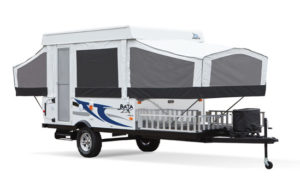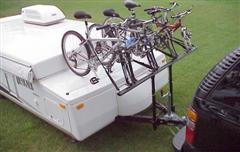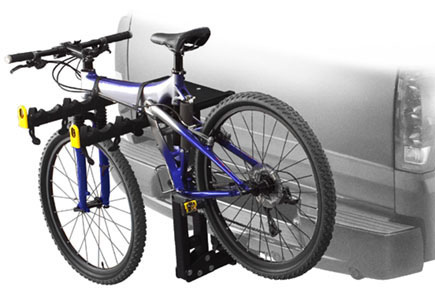Pop Up Camper Bike Racks Explained
Whether you’re into BMX, mountain biking, or you just like to tool around the campground, biking and camping go hand in hand. Even if you aren’t the biggest fan of cycling for fun, having a bike around when you’re camping can come in real handy if you need to get somewhere without unhooking your tow vehicle. And since bikes aren’t especially heavy or cumbersome, there’s a way for just about anyone to bring at least a couple along. Of course, like with so many other things, pop up campers present a somewhat unique challenge when it comes to bringing your bikes along for a camping trip. Since you can’t stow your bikes inside, like you can with a travel trailer, the easiest solution is to go with a specially-designed bike rack for pop up camper use. Depending on your tow vehicle and trailer situation, you may also be able to rig up your own pop up camper bike rack solution.
Types of Bike Racks
First off, it’s important to have a good idea of what types of racks are out there. In general, there are three different main categories of bike racks:
- bumper-mounted
- roof-mounted
- hitch-mounted
Bumper-mounted Bike Racks
These racks are designed to be bolted straight to a bumper, which makes them incredibly versatile. These bike racks are almost universally intended to be mounted to the back bumper of a motorized vehicle, but a little bit of ingenuity can allow you to mount one to your front bumper or even to the back bumper of a trailer. Some of these racks can even be repurposed to be mounted to the tongue of a trailer above the propane tanks, although not all off-label uses of these racks are actually recommended (or even safe). Some of these racks can carry up to four or five bikes, although not all bumpers can handle that much weight.
Roof-mounted Bike Racks
Although these carriers are somewhat less versatile, there is still a lot of variety out there. Most of these racks require an existing rail system, which rules out any tow vehicle that doesn’t have roof rails. Other roof-mounted bicycle carriers can be mounted to any roof, and some can even be ginned up for attachment to the roof of a pop up camper. Most of these racks are designed for one or two bikes, and some of them require you to remove the front wheel of a bike before loading it. One main drawback of this type of rack is increased wind resistance, which can partially cancel out the benefit of towing a low-profile pop up camper vs. a taller travel trailer.
Hitch-mounted Bike Racks
In a way, hitch-mounted bike racks are the lest versatile of the three main categories of bicycle carriers. These racks require a trailer hitch receiver to work, which means they can’t be used with a vehicle that doesn’t have a receiver. It also means that this type of rack can’t be mounted on the front of a vehicle unless it has a front-facing receiver, and it can’t be mounted on a trailer unless the trailer has a receiver installed–probably for this express purpose. Of course, hitch-mounted bike racks also introduce another issue: how do you install a bike rack in your hitch receiver if you’re towing a pop up camper?
There’s actually a pretty simple answer to that question, and there are a lot of situations where a hitch-mounted bike rack is the best way to go. Since these racks can typically hold more weight than other carriers, this design can actually make for a really great pop up camper bike rack. Of course, there are a few issues that you have to take into consideration before installing a hitch-mounted pop up camper bike rack.
Pop Up Camper Bike Racks
In addition to the three main types of racks that can be used in conjunction with a tow vehicle or pop up camper itself, there are also some bicycle carriers that are specifically designed for use with pop up campers. For example, this Pro Rac Systems bicycle rack is designed to mount onto the towing frame for good stability. It carries up to four bikes at once, and it can be adjusted to fit most pop up campers.
Click for full details, reviews, and pricing information on Amazon.com
Of course, given a little time and the right hardware, you can also make virtually any hitch-mounted rack work with a pop up camper.
Using a Hitch-mounted Bike Rack for a Pop Up Camper
In order to make a hitch-mounted pop up camper bike rack work, you’ll need an additional piece of equipment. There are a number of accessories that will work in this situation, including either a multi-use ball mount and a dual hitch extender. A multi-use ball mount fits into your hitch receiver and provides you with both a ball mount and an an additional receiver. In order for this to work, the ball needs to be beneath the receiver. You will attach your pop up camper to the ball mount and slide your bike rack into the receiver above it, so there are spacing issues to consider with this type of configuration. On the other hand, a dual hitch extender provides two female hitch receivers: one for your pop up camper and the other for your bike rack.
When using a hitch-mounted pop up camper bike rack, there are a handful of additional considerations that you need to take into account. The most important is your turning radius. If the bikes on your rack will interfere with your propane tank–or the body of your pop up camper itself–then this type of bike rack won’t work. With that in mind, you may want to hitch up your rig and take some measurements before buying a pop up camper bike rack. If you take measurements with the tow vehicle and trailer in a straight line configuration, and then take measurements again after turning the wheel all the way left or right and driving forward, you’ll be able to get an idea of how much space you have to work with.
Since turning radius can be a concern, you may be limited as to how many bikes you can carry on a bumper-mounted pop up camper bike rack. Although these racks can often carry five or more bikes, you may only be able to fit a two bike rack in your available space. In that case, you may want to explore your other options.
Pop Up Camper Bike Rack Options
If you’re looking for a bike rack for a pop up camper, it’s possible to make carriers from any of the three main categories work. However, some of them will work better in certain situations than others. If you already have a roof rack, and you don’t notice a huge drop in fuel economy when you use it, then you’re probably fine to just use that when you’re towing your pop up camper. Since most of these racks only carry one or two bikes, and bicycles tend to be fairly light, weight probably isn’t going to be a concern either.
If you either modify a bumper-mounted bike rack for pop up camper use, or go with a hitch-mounted pop up camper bike rack, then weight may be an issue. When calculating how much weight your tow vehicle can handle, you have to add in both the weight of the rack and the weight of the bikes. If you have a lightweight aluminum rack and a single bike, you’re not adding a whole lot to the total, but you should still figure it in. On the other hand, those pounds can really stack up fast if you have a heavy steel or iron rack and enough bikes for your family of five (plus some for the kids’ friends).
When taking the combined weight of your pop up camper bike rack and bikes into consideration, it’s also important to factor in where the bike rack is mounted. If it’s mounted on the roof, then you can treat it like weight inside the vehicle (i.e. the combined weight of all the passengers and cargo in your car or truck), which has to be taken into account when trying to stay within your GCWR. The same is true if you attach a bumper-mounted rack to the front of your vehicle, although at that point you might want to also consider the fact that all of the additional weight is on your front axle.

A pop up toy hauler is built to carry bikes and other gear.
If you attach a pop up camper bike rack to the roof or bumper of your camper, then you need to think about both the amount of weight your vehicle can tow and the amount of cargo weight that your camper can handle. Mounting the bike rack on the pop up camper’s bumper, or over the tongue, can also alter the tongue weight. You’ll probably also run into a situation where the bumper of your pop up camper can’t handle the additional weight, in which case you’ll have to actually mount the rack to its frame. And even then, adding that additional weight to the back of a pop up camper can drastically affect its handling characteristics (in a negative way.)
If you’re unsure about how much weight your tow vehicle or pop up camper can handle, or how a heavily-loaded bike rack might play into things, you should check your owners manual–or even consult your local dealer–before you make a decision.



